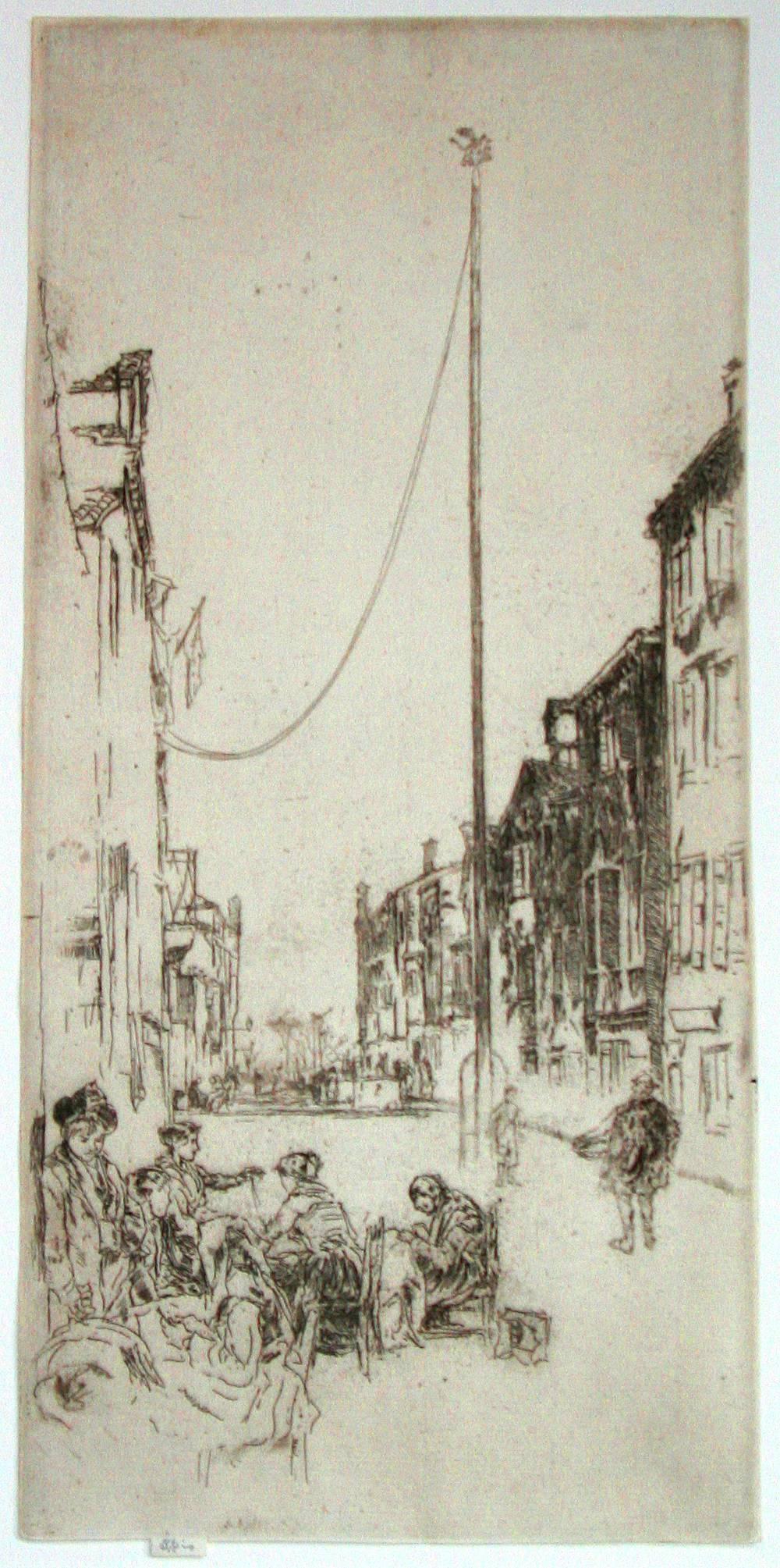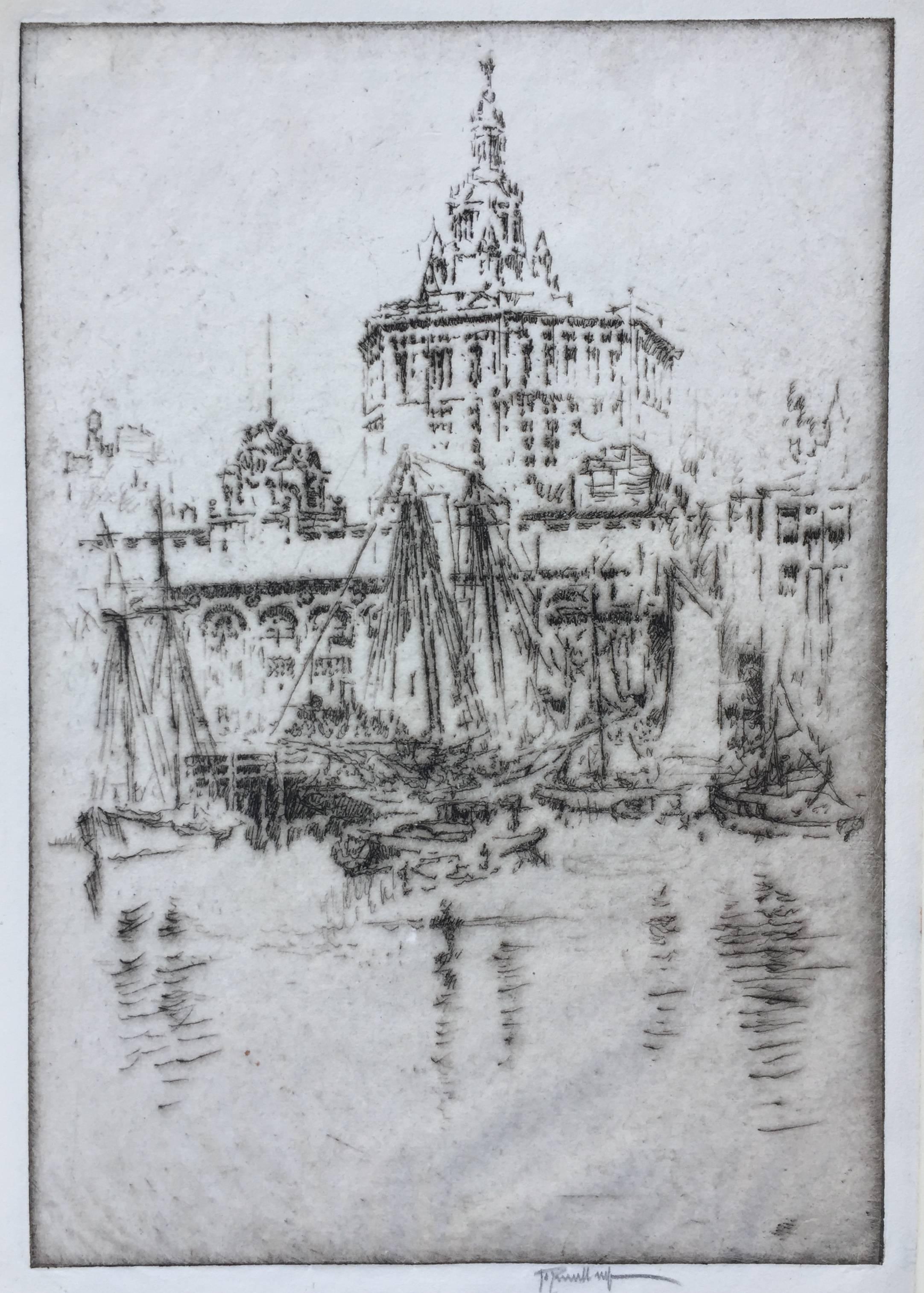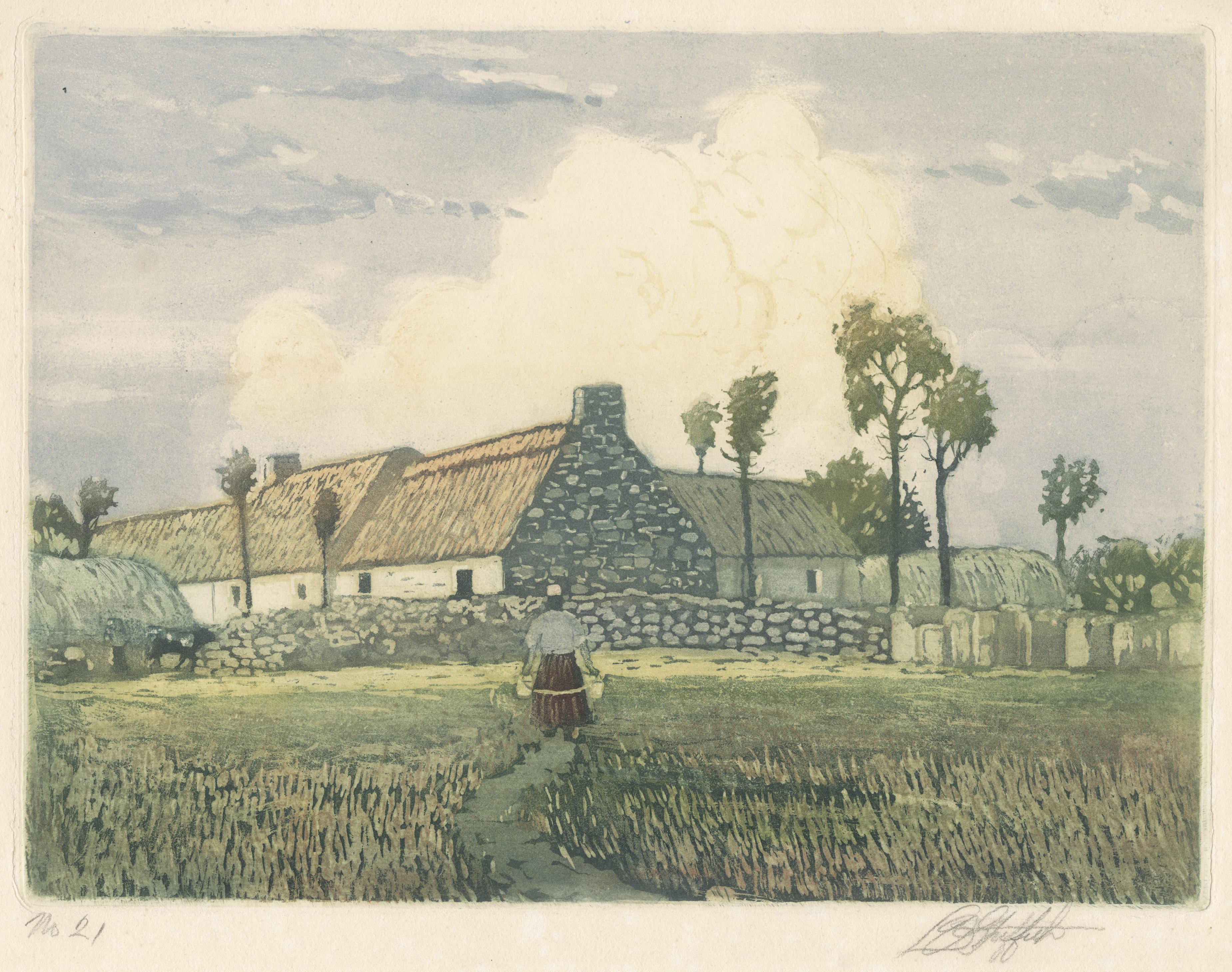Items Similar to 'Black Hawk Country' — Early 20th-Century American Impressionism
Want more images or videos?
Request additional images or videos from the seller
1 of 3
Ralph M. Pearson'Black Hawk Country' — Early 20th-Century American Impressionism1912
1912
About the Item
Ralph M. Pearson, 'Black Hawk Country', etching, second state, edition not stated, 1912. Signed, and titled in pencil. Inscribed 'Rock River Series Second State'. A superb, richly-inked, atmospheric impression, in dark brown ink with selectively wiped plate tone, on cream wove Japan paper; the full sheet with margins (1 1/8 to 1 5/8 inches), in excellent condition.
Image size 8 7/8 x 13 13/16 inches); sheet size 11 5/8 x 16 3/4 inches. Matted to museum standards, unframed. Scarce.
Exhibited: 'Annual Exhibition of the Association of American Etchers', 1914.
Reproduced: 'Year Book of American Etching, 1914', John Lane Company, New York, 1914.
- Creator:Ralph M. Pearson (1883 - 1958)
- Creation Year:1912
- Dimensions:Height: 8.88 in (22.56 cm)Width: 13.82 in (35.11 cm)
- Medium:
- Movement & Style:
- Period:
- Condition:
- Gallery Location:Myrtle Beach, SC
- Reference Number:
About the Seller
5.0
Recognized Seller
These prestigious sellers are industry leaders and represent the highest echelon for item quality and design.
Platinum Seller
These expertly vetted sellers are 1stDibs' most experienced sellers and are rated highest by our customers.
Established in 1995
1stDibs seller since 2016
259 sales on 1stDibs
Typical response time: 1 hour
Associations
International Fine Print Dealers Association
- ShippingRetrieving quote...Ships From: Myrtle Beach, SC
- Return PolicyA return for this item may be initiated within 7 days of delivery.
More From This SellerView All
- St. Paul's Church (St. Paul's Chapel, New York City)By Bror Julius Olsson NordfeldtLocated in Myrtle Beach, SCB.J.O. Nordfeldt, 'St. Paul's Church' (St. Pauls' Chapel), etching, edition not stated, c. 1915. Signed in pencil. A superb, richly-inked impression, with skillfully controlled plate tone, printed on off-white, antique, laid paper; the full sheet with margins (5/8 to 2 1/4 inches), in very good condition. Scarce. Matted to museum standards, unframed. An impression of this work is in the permanent collection of the Smithsonian American Art Museum. ABOUT THE ARTIST A solo exhibition of Nordfeldt’s etchings and woodcuts was presented by the Smithsonian Institution in 1926. In 1920, Nordfeldt had a one-man show at the Chicago Arts Club. In 1926, he won the bronze medal at the sesquicentennial exposition in Philadelphia and the Logan Medal at the Art Institute of Chicago. In 1927, he won the first annual prize from the Brooklyn Society of Etchers, and the following year he won first prize from the Chicago Society of Etchers. In 1929, Nordfeldt had a one-man show at the Denver Art Museum. Nordfeldt's work is held in numerous museum collections including Amon Carter Museum of Western Art, Ft. Worth; Anschutz Collection, Denver; Art Institute of Chicago; Biblioteque d’Art et d’Archeologie, Paris; British Museum, London; Corcoran Gallery of Art, Washington, DC; Los Angeles County Museum; Metropolitan Museum of Art, New York City; Museum of Fine Arts, Santa Fe; National Museum of American Art, Smithsonian Institution, Washington, DC; National Gallery, Sydney, Australia; Phillips Collection, Washington, DC. ABOUT ST. PAUL'S CHAPEL St. Paul's Chapel, nicknamed "The Little Chapel That Stood", is an Episcopal chapel located at 209 Broadway, between Fulton Street and Vesey Street, in Lower Manhattan, New York City. Built in 1766, it is the oldest surviving church building in Manhattan, and one of the nation's finest examples of Late Georgian church architecture. It is a New York City Landmark and a National Historic Landmark. The Hearts of Oak, a militia unit organized early in the American Revolutionary War, and composed in part of King's College (later, Columbia University) students, would drill in the Chapel's yard before classes nearby. Alexander Hamilton was an officer of this unit. The chapel survived the Great New York City Fire of 1776 when a quarter of New York City (then confined to the lower tip of Manhattan), including Trinity Church, burned following the British capture of the city after the Battle of Long Island during the American Revolutionary War. George Washington, along with members of the United States Congress, worshipped at St. Paul's Chapel on his Inauguration Day, April 30, 1789. Washington also attended services at St. Paul's during the two years New York City was the country's capital. Above Washington's pew is an 18th-century oil painting of the Great Seal of the United States, adopted in 1782. The rear of St. Paul's Chapel faces Church Street, opposite the east side of the World Trade Center site. After the attacks on September 11, 2001, which led to the collapse of the twin towers of the World Trade Center, St. Paul's Chapel served as a place of rest and refuge for recovery workers at the WTC site. For eight months, hundreds of volunteers worked 12-hour shifts around the clock, serving meals, making beds, counseling and praying with firefighters, construction workers, police, and others. Massage therapists, chiropractors, podiatrists, and musicians also tended to their needs. The church survived without even a broken window. Church history declares it was spared by a miracle sycamore on the northwest corner of the property that was hit by debris. The tree's root has been preserved in a bronze memorial...Category
1910s American Impressionist Landscape Prints
MaterialsEtching
- 'North Boulder Creek, Colorado' —Southwest American ImpressionismBy George Elbert BurrLocated in Myrtle Beach, SCGeorge Elbert Burr, 'North Boulder Creek, Colorado', etching, c. 1915, Seeber 99. A superb, luminous impression, in dark sepia ink, with skilfully wiped plate tone, on cream laid pap...Category
1910s American Impressionist Landscape Prints
MaterialsEtching
- Broad Street (Wall Street)By Bror Julius Olsson NordfeldtLocated in Myrtle Beach, SCB.J.O. Nordfeldt, 'Broad Street (Wall Street)', etching, edition not stated, c. 1915. Signed in pencil. A superb impression, with rich burr, selectively wiped plate tone, and inky plate edges, on cream wove paper; the full sheet with margins (3/4 to 1 1/4 inches), in excellent condition. Printed by the artist. Matted to museum standards, unframed. Impressions of this work are in the permanent collections of the Fine Arts Museums of San Francisco, Princeton University, Smithsonian American Art Museum. A view looking down Broad Street past the New York Stock Exchange Building on the right with the columned Federal Hall...Category
1910s American Impressionist Landscape Prints
MaterialsEtching
- 'Ship Rock, New Mexico' —By Albert GrollLocated in Myrtle Beach, SCAlbert Lorey Groll, 'Ship Rock, New Mexico', etching, c. 1910. Signed and titled in pencil. A fine, richly-inked impression on cream, wove paper, the full sheet with margins (1 to 1 3/8 inches); a slight paper defect in the center-left margin, away from the image, otherwise in excellent condition. Image size 7 7/8 x 10 inches (200 x 254 mm); sheet size 10 1/8 x 12 15/16 inches (257 x 329 mm). Scarce. Provenance: Ex. collection Kennedy Galleries, in their original gallery mat with label attached. ABOUT THE ARTIST Albert Lorey Groll (1866-1910) was born in New York in 1866, the son of a pharmacist immigrant from Darmstadt, Germany. During his early years, he traveled to Europe to study at the Royal Academy of Fine Arts in Munich under Nicholas Gysis and Ludwig von Löfftz. He further pursued his studies in London and at the Royal Academy of Fine Arts in Antwerp, Belgium. Groll returned to New York in 1895 and moved from figure to landscape painting while expanding his interests to printmaking. In 1904 Groll made the first of several trips to the American Southwest, traveling to Arizona with ethnographer Stewart Culin of the Brooklyn Museum. Later he went to New Mexico with his friend, the artist and illustrator William Robinson Leigh (see our 1stDibs listing no. LU53239015112 ). He focused on impressionistic scenes of Native American lands. The Laguna Pueblo people admired Groll's paintings, honoring him with the name "Chief Bald Head Eagle Eye." Groll kept a studio in the Gainsborough Studios in Manhattan and won several awards for his work in Arizona and New York, including the Salmagundi Club Shaw Prize in 1904 and a gold medal at the Pennsylvania Academy of Fine Arts in 1906. He was also awarded the George Inness gold medal from the National Academy of Design in 1912 for his painting of Lake Louise in the Canadian Rockies. In 1910 he was elected into the National Academy of Design and, in 1919, an associate member of the Taos Society...Category
1910s American Impressionist Landscape Prints
MaterialsEtching
- ShippingBy Kerr EbyLocated in Myrtle Beach, SCKerr Eby 'Shipping' also 'Shipping, Connecticut', etching and sandpaper ground, 1932, edition 100, Giardina 171. Signed in pencil and titled 'Shipping' in the bottom left sheet edge. A superb, atmospheric impression, with skillfully controlled plate tone, on heavy, cream wove paper; the full sheet with wide margins (2 to 2 3/4 inches), in excellent condition. Matted to museum standards, unframed. Image size 8 3/8 x 17 1/4 inches (316 x 176 mm); sheet size 13 7/16 x 8 3/8 inches (341 x 213 mm). The scene depicted was on the Connecticut coast...Category
1940s American Impressionist Landscape Prints
MaterialsEtching
- 'Skaters' — 1930s Woodstock, New YorkBy Emil GansoLocated in Myrtle Beach, SCEmil Ganso, 'Skaters', pochoir (color stencil) with hand painting, edition c. 50, 1938, Smith S-6. Signed in the image, lower right. A rich, painterly impression, with fresh colors, on buff wove paper; the full sheet with margins (7/8 to 1 7/8 inches), in excellent condition. Matted to museum standards, unframed. Image size 11 3/4 x 15 1/4 inches; sheet size 18 3/4 x 13 3/4 inches. An impression of this work is in the permanent collection of the Philadelphia Museum of Art. ABOUT THE ARTIST Born in Germany, Emil Ganso (1895-1941) came to the United States with his family in 1912. After settling in New York City, he found night work in a bakery and concentrated on his art in the daytime—mostly self-taught at this time, he studied only briefly at the National Academy of Design. In 1924, Ganso showed his drawings to Carl Zigrosser, who organized the artist’s first solo exhibition, at the Weyhe Gallery. Soon afterward, Ganso enrolled in Eugene Fitsch’s printmaking class at the Art Students League. Although he considered himself primarily a painter, Ganso made prints in all media, including relief and stencil prints and complex intaglios, and even experimented with color lithography in the late 1920s. He also developed, with an engineer, the design and fabrication of an innovative etching press. In 1926, Ganso attended the Art Students League summer session in Woodstock, New York. There, he met Jules Pascin, and the two artists began a close friendship, briefly sharing a studio. Ganso followed Pascin to Europe in 1928. In 1929, Ganso returned to New York and showed his work regularly in group exhibitions. He continued working in Woodstock in the summer months, often printing lithographs for other artists. The Cleveland Print Club...Category
1930s American Impressionist Landscape Prints
MaterialsGouache, Stencil
You May Also Like
- The Venetian MastBy James Abbott McNeill WhistlerLocated in Storrs, CTThe Venetian Mast. 1879-80. Etching and drypoint. Kennedy catalog 195 state .vi; Glasgow catalog 219 state x/xii. 13 3/8 x 6 3/8. Glasgow records 53 impressions. A fine, atmospheric...Category
1870s American Impressionist Landscape Prints
MaterialsDrypoint, Etching
- New Fish Market - NEW YORKBy Joseph PennellLocated in Santa Monica, CAJOSEPH PENNELL (1857 - 1926) NEW FISH MARKET - (NEW YORK) 1921 (W 797) Etching, Signed in pencil, edition probably 50. 9 7/8 x 6 7/8 inches. Full sheet, ...Category
1920s American Impressionist Landscape Prints
MaterialsEtching
- Desolation, S.C. or Deserted Cabins, Beauford, S.C.By Louis Oscar GriffithLocated in Fairlawn, OHDesolation, S.C. or Deserted Cabins, Beauford, S.C. Etching & Aquatint, c. 1930 Signed by the artist in pencil lower right (see photo) Annotated "Trial Proof" in pencil lower left co...Category
1930s American Impressionist Landscape Prints
MaterialsAquatint
- Brittany Landscape with FigureBy Louis Oscar GriffithLocated in Fairlawn, OHBrittany Landscape with Figure Etching & color aquatint, c. 1920 Signed lower right (see photo) Numbered lower left: "No. 21" (see photo) An early ...Category
1920s American Impressionist Landscape Prints
MaterialsAquatint
- Five Pigeons (Jardin du Luxembourg, Paris)By Harold AltmanLocated in San Francisco, CAArtist: Harold Altman (American, 1924-2003) Title: Five Pigeons (Jardin du Luxembourg, Paris) Year: 1981 Medium: Original color etching with aquatint Edition: Numbered 75/200 in pencil Paper: Arches Image (plate mark) size: 11.75 x 8.25 inches Framed size: 24.5 x 17.65 inches Signature: Hand signed and titled in pencil by the artist Condition: It is in very good condition, the matting have some marks, see picture #1 Frame: Custom framed in a wooden silver frame frame, with fabric matting and brownish green fillet. About the artist. Printmaker Harold Altman was an etcher, painter, and teacher, who was born in New York City in 1924. He attended the Art Students League, 1941-42 and Cooper Union, (Graduate in Fine Arts), 1941-47, both in New York City. In 1946, he attended Black Mountain College, North Carolina and then went on to The New School, New York City 1947-49. Finishing his extensive art education at the L'Academie de la Grande Chaumiere in Paris 1949-52. Altman settled in the central Pennsylvanian village of Lemont in 1962, where a nineteenth-century frame church serves as his studio. Approximately four months out of the year are spent working in Paris where his lithographs are printed at Atelier DesJobert. In previous years, his etchings were printed at Atelier George LeBlanc. Altman's landscapes and figurative works have been exhibited at numerous galleries and museums, both in the United States and abroad. He is represented in nearly every significant collection in the world. New York's Museum of Modern Art owns over forty Altmans while the Whitney Museum of American Art and Brooklyn Museums each have over fifty of his works in their permanent collections. His work is to be found in many significant museum collections outside of the United States, several of which are the Victoria and Albert Museum of London, the Stedelijk Museum of Amsterdam, the Kunst Museum of Basel, the Royal Museum of Fine Arts of Copenhagen and the Bibliotheque Nationale of Paris. OVER 300 ONE-MAN EXHIBITIONS (PARTIAL LISTING) Galerie Huit - Paris (1951) The Art Institute of Chicago - (1960) The Escuela Nacional de Artes Plasticas - Mexico City (1961) The San Francisco Museum of Art - (1961) The Santa Barbara Museum of Art - (1961) Oklahoma Art Center - (1966, 1976) The Southeastern Center for Contemporary Art - Winston-Salem, NC (1976) Milwaukee Art Center - (1969) The Print Cabinet...Category
Late 20th Century American Impressionist Landscape Prints
MaterialsEtching, Aquatint
- Birch Grove, Signed Etching by Harvey KidderBy Harvey KidderLocated in Long Island City, NYBirch Grove Harvey Kidder, American (1918–2001) Date: circa 1985 Aquatint Etching, Signed and numbered in Pencil Edition of 150 Size: 33 in. x 29.5 in. (83.82 cm x 74.93 cm)Category
1980s American Impressionist Landscape Prints
MaterialsEtching
Recently Viewed
View AllMore Ways To Browse
Japan Antique Paper
Antique Japanese Paper
Antique American Standard
The Hawk
Anders Pearson
Hawk Print
Antique Japanese Book Prints
Hawk Etching
Ralph Pearson
Oscar Bryn
Paravents Buffet
Peter Milton On Sale
Ralph Fasanella On Sale
Richard Earlom On Sale
Rick Dula On Sale
Robbert G
Rosamond Tudor On Sale
Rowena Fry



